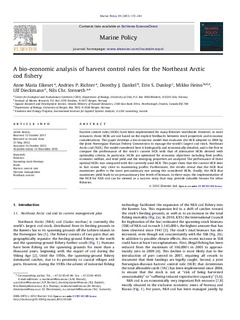| dc.contributor.author | Eikeset, Anne Marie | |
| dc.contributor.author | Richter, Andries Peter | |
| dc.contributor.author | Dankel, Dorothy | |
| dc.contributor.author | Dunlop, Erin | |
| dc.contributor.author | Heino, Mikko | |
| dc.contributor.author | Dieckmann, Ulf | |
| dc.contributor.author | Stenseth, Nils Christian | |
| dc.date.accessioned | 2015-04-01T07:53:22Z | |
| dc.date.accessioned | 2015-05-06T06:54:45Z | |
| dc.date.available | 2015-04-01T07:53:22Z | |
| dc.date.available | 2015-05-06T06:54:45Z | |
| dc.date.issued | 2012-12-12 | |
| dc.identifier.citation | Eikeset, A. M., Richter, A. P., Dankel, D. J., Dunlop, E. S., Heino, M., Dieckmann, U., & Stenseth, N. C. (2013). A bio-economic analysis of harvest control rules for the Northeast Arctic cod fishery. Marine Policy, 39(0), 172-181. doi: http://dx.doi.org/10.1016/j.marpol.2012.10.020 | nb_NO |
| dc.identifier.issn | 0308-597X | |
| dc.identifier.uri | http://hdl.handle.net/11250/283127 | |
| dc.description | - | nb_NO |
| dc.description.abstract | Harvest control rules (HCRs) have been implemented for many fisheries worldwide. However, in most instances, those HCRs are not based on the explicit feedbacks between stock properties and economic considerations. This paper develops a bio-economic model that evaluates the HCR adopted in 2004 by the Joint Norwegian–Russian Fishery Commission to manage the world's largest cod stock, Northeast Arctic cod (NEA). The model considered here is biologically and economically detailed, and is the first to compare the performance of the stock's current HCR with that of alternative HCRs derived with optimality criteria. In particular, HCRs are optimized for economic objectives including fleet profits, economic welfare, and total yield and the emerging properties are analyzed. The performance of these optimal HCRs was compared with the currently used HCR. This paper show that the current HCR does in fact comes very close to maximizing profits. Furthermore, the results reveal that the HCR that maximizes profits is the most precautionary one among the considered HCRs. Finally, the HCR that maximizes yield leads to un-precautionary low levels of biomass. In these ways, the implementation of the HCR for NEA cod can be viewed as a success story that may provide valuable lessons for other fisheries. | nb_NO |
| dc.language.iso | eng | nb_NO |
| dc.publisher | Elsevier | nb_NO |
| dc.title | A bio-economic analysis of harvest control rules for the Northeast Arctic cod fishery | nb_NO |
| dc.type | Journal article | nb_NO |
| dc.type | Peer reviewed | nb_NO |
| dc.date.updated | 2015-04-01T07:53:22Z | |
| dc.subject.nsi | VDP::Agriculture and fishery disciplines: 900::Fisheries science: 920::Resource biology: 921 | nb_NO |
| dc.subject.nsi | VDP::Agriculture and fishery disciplines: 900::Fisheries science: 920::Catch: 925 | nb_NO |
| dc.source.pagenumber | 172-181 | nb_NO |
| dc.source.volume | 39 | nb_NO |
| dc.source.journal | Marine Policy | nb_NO |
| dc.identifier.doi | 10.1016/j.marpol.2012.10.020 | |
| dc.identifier.cristin | 1012152 | |
